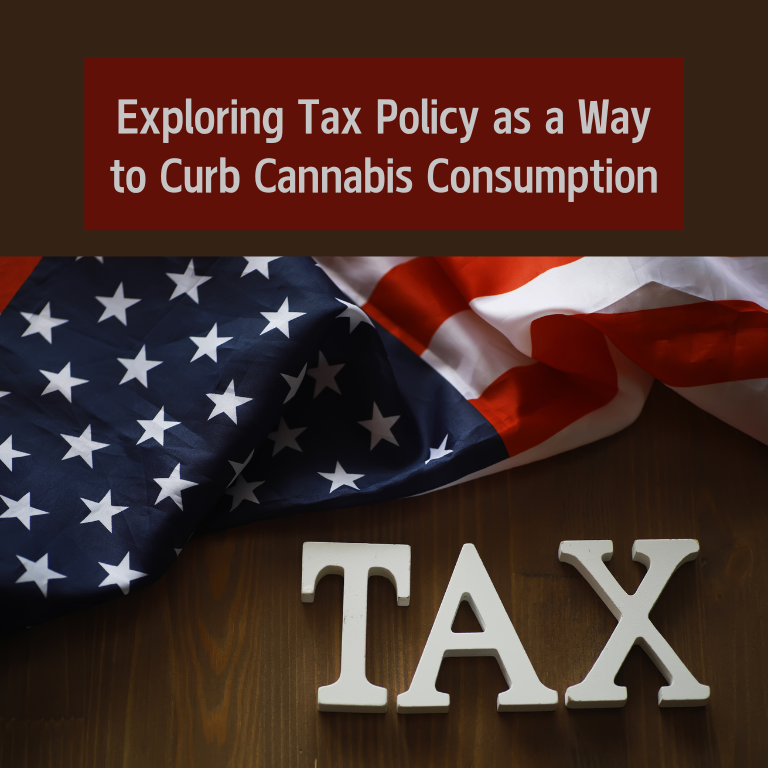As the legalization of cannabis spreads across the United States and beyond, policymakers face a growing need to manage its consumption responsibly. One approach gaining attention is the use of tax policy to influence purchasing behaviors and curb excessive cannabis consumption. Similar to the strategies used for alcohol and tobacco, taxation on cannabis products could be a powerful tool in shaping consumer behavior, regulating the market, and generating government revenue. This article examines the role of tax policy in managing cannabis consumption, the potential impact on public health, and the challenges involved in implementing effective tax measures.
The Role of Tax Policy in Cannabis Markets
Taxation has long been a method for managing the consumption of goods with potential health risks, such as alcohol and tobacco. With the rise of legal cannabis markets, many governments are adopting similar strategies. Taxes on cannabis products serve a dual purpose: they generate revenue for public services and act as a deterrent to overconsumption by raising the product’s price. By increasing the price, taxes can help reduce demand, particularly among price-sensitive consumers such as young adults and occasional users.
However, striking the right balance is critical. Excessive taxes can lead to unintended consequences, such as pushing consumers toward the black market, while insufficient taxes may do little to curb consumption. Policymakers must carefully consider the level and structure of cannabis taxes to achieve both public health and fiscal goals.
Types of Cannabis Taxes
To effectively curb cannabis consumption, policymakers have several types of tax structures they can implement. Each approach has distinct advantages and disadvantages, and choosing the right type of tax is crucial to influencing consumer behavior.
- Excise Taxes
Excise taxes are levied directly on cannabis products and are typically calculated based on weight, potency, or price. These taxes are often set at a higher rate than general sales tax, reflecting the product’s potential health risks.
Weight-based excise taxes: Taxing cannabis by weight can make higher quantities of cannabis more expensive, deterring consumers from purchasing large amounts. However, this approach doesn’t account for potency, meaning high-THC products might be taxed the same as lower-potency ones.
Potency-based excise taxes: This tax method charges higher rates for cannabis products with higher THC levels, targeting products with stronger psychoactive effects. Potency-based taxes aim to reduce consumption of highly potent products, which are more likely to contribute to overuse or health risks.
Price-based excise taxes: This structure imposes taxes as a percentage of the product’s retail price, similar to sales tax. While easy to implement, price-based excise taxes are subject to market fluctuations, which can impact tax revenue stability.
- Sales Taxes
Sales taxes on cannabis are added at the point of sale and apply to the product’s retail price. While sales taxes are straightforward and widely understood by consumers, they can be less effective at targeting specific types of products or levels of potency. Many states use a combination of sales and excise taxes to optimize both revenue generation and consumption control.
- Local and Regional Taxes
In addition to state or national cannabis taxes, local governments may impose additional taxes to address community-specific concerns. Local taxes can fund public health initiatives, education, and law enforcement efforts aimed at reducing cannabis misuse. However, higher local taxes can drive consumers to neighboring areas with lower tax rates, so coordination among jurisdictions is essential.
Public Health Benefits of Cannabis Taxation
Implementing well-structured cannabis taxes can yield public health benefits by discouraging excessive use, particularly among vulnerable populations. Taxing cannabis can influence both the frequency and quantity of consumption, leading to potential long-term health benefits.
Reduced Consumption Among Young Adults
Young adults and adolescents are among the most price-sensitive consumers, making tax increases an effective deterrent for these groups. Higher taxes make cannabis products less affordable, potentially delaying the age at which young people start using cannabis and reducing the likelihood of regular use. This can be particularly beneficial, as early and frequent cannabis use is associated with higher risks of dependency and cognitive impairment.
Encouraging Moderation and Responsible Use
By targeting high-potency products, taxes can encourage moderation and responsible cannabis use. Potency-based taxes discourage consumers from purchasing stronger products that are associated with higher health risks, steering them toward lower-potency options that pose fewer risks. This approach aligns with harm reduction strategies, aiming to minimize the negative impacts of cannabis use without restricting access for adults.
Funding for Education and Treatment Programs
Revenue from cannabis taxes can be allocated to public health initiatives, including educational programs on responsible cannabis use and treatment services for those struggling with dependency. Many states with legalized cannabis markets have used tax revenue to support community health services, substance abuse prevention programs, and research on the effects of cannabis. This reinvestment in public health helps address the broader social impacts of cannabis consumption.
Challenges and Considerations in Implementing Cannabis Taxes
While tax policy can be an effective tool for managing cannabis consumption, several challenges must be addressed to maximize its effectiveness. These challenges include balancing tax rates, addressing black market competition, and ensuring that tax revenue is used effectively.
Balancing Tax Rates to Avoid Unintended Consequences
Setting the right tax rate is crucial. Excessive taxes can make legal cannabis unaffordable, driving consumers to the unregulated black market, where products are untaxed and may pose greater health risks due to lack of quality control. To combat this, some states have adopted moderate tax rates that generate revenue without significantly raising prices, aiming to keep consumers in the legal market.
Competition with the Black Market
The black market remains a significant concern in states with legal cannabis, as high taxes on legal products can make them less competitive. Consumers may turn to unlicensed sellers if taxed products become too expensive, reducing both tax revenue and the effectiveness of policies aimed at curbing use. Policymakers must consider the potential for black-market competition when setting tax rates, working to strike a balance that discourages illicit sales.
Ensuring Effective Use of Tax Revenue
For cannabis taxes to deliver public health benefits, it is essential that revenue is allocated to initiatives that address the social and health impacts of cannabis use. This can include funding for prevention programs, public health research, substance use treatment, and law enforcement. Transparency and accountability in the use of tax revenue are essential for maintaining public trust and demonstrating the benefits of taxation as a regulatory tool.
Equity Concerns
High taxes on cannabis can disproportionately impact lower-income individuals, raising questions about equity and fairness. Policymakers need to be mindful of the economic impact of cannabis taxes, considering options such as tiered tax rates or exemptions for medical cannabis users. By addressing these equity concerns, governments can implement policies that are both effective in curbing excessive use and fair to all consumers.
Lessons from Alcohol and Tobacco Taxation
The success of taxation in managing alcohol and tobacco consumption provides valuable insights for cannabis policymakers. Alcohol and tobacco taxes have proven effective in reducing consumption rates, especially among young people. However, the success of these taxes is largely dependent on the careful calibration of rates, transparency in revenue allocation, and comprehensive public education.
Policymakers can apply these lessons to cannabis taxation by ensuring that rates are set appropriately, revenue is used to support health initiatives, and public messaging emphasizes responsible use. By learning from alcohol and tobacco policies, governments can develop effective cannabis tax strategies that balance revenue generation with public health goals.
Future Directions for Cannabis Tax Policy
As cannabis markets evolve, tax policy will continue to play a central role in shaping consumption patterns. Policymakers are likely to experiment with different tax structures, potentially refining potency-based taxes, adjusting rates based on consumer behavior, and enhancing coordination between state and local governments.
In the coming years, it is expected that more research will shed light on the effectiveness of different tax structures for cannabis. This data will help policymakers refine their approaches, using tax policy not only to manage consumption but also to support the broader goals of public health, economic stability, and social equity.
Tax policy has the potential to be an effective tool for curbing cannabis consumption and promoting responsible use. By carefully designing taxes based on product potency, sales, and local needs, governments can influence consumer behavior while generating revenue for public health initiatives. However, policymakers must remain mindful of challenges such as black market competition, equitable access, and the need for effective revenue allocation.
With lessons learned from alcohol and tobacco taxation, and an eye toward public health, cannabis taxes can become a key component of responsible cannabis regulation, ultimately contributing to a balanced and sustainable approach to legal cannabis markets.














